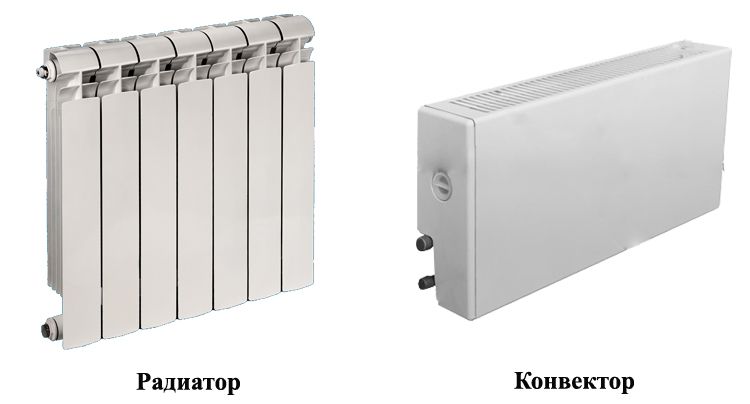How to choose a convector
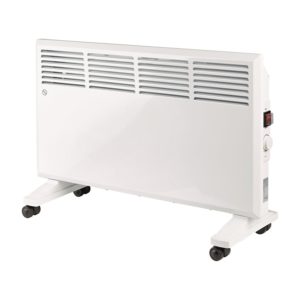 Convectors are devices in which a heating element warms the warm air in the apartment by creating natural air circulation (convection), rather than radiation, like radiators.
Convectors are devices in which a heating element warms the warm air in the apartment by creating natural air circulation (convection), rather than radiation, like radiators.
The content of the article
How to choose a convector for a dacha, apartment and private house
If you want to choose the right convector for your dacha, apartment or house, you need to pay attention to many parameters, which we will consider below.
Power
When choosing a device, it is necessary to calculate the power that we need. To do this you need to follow simple rules:
- if the room has one window with one outer wall, then 1 kW of power is needed per 10 sq. m. room (that is, if we have a room of 30 sq. m., we need a convector with a power of 3 kW);
- with two external walls and one window, 20% must be added to the calculated power;
- if there are 2 external walls and 2 windows, then 30%.
There are other methods for calculating power, based on the specifics of the premises and their volume. For example:
- premises built according to Scandinavian standards - 20 W per cubic meter of room;
- using medium thermal insulation standards - 30 W per cubic meter;
- with poor thermal insulation - 40 W per cubic meter;
- and with minimal thermal insulation (warehouses, garages, etc.) - 50 W per cubic meter.
For more detailed calculations, you can use other calculation methods. But since we are talking about relatively small rooms, such detailed calculations are not required. For central Russia, the first method considered is sufficient. Some recommend making a simpler calculation: per 1 square meter the power is 0.1 kW.
You should also pay attention to such points. For bad windows, it is recommended to increase the power by 10%. And in corner apartments, multiply by a factor of 1.2.
Having calculated the required power, we proceed to selecting a suitable model.
Typically, the power of an average device for ordinary users is 0.5-3 kW.
Installation method
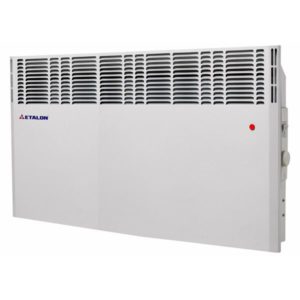
Convectors come in different types:
- electrical;
- water;
- gas.
Therefore, we will consider the methods and features of installing each of them.
For a water device, the main element is the battery. When installing this type of equipment, additional components are required for connection. As a rule, they are made of copper so that they can resist corrosion, unlike aluminum and steel. But they will significantly increase the cost of installation.
Its installation begins by first securing the battery to the wall. Then, using pipes, the battery is connected to the heating system. Minus, if you do not have a heating system, then you will not be able to connect this type of convector.
Installing an electrical device is much easier. To do this, just choose a suitable place on the wall and attach it. In this case, you should follow some rules:
- At least 20 cm is required between the floor and the convector.
- No more than 25 cm from the wall, and at least 55 cm from the ceiling.
- The distance to the sockets should be 35 cm or more.
- After installation, you can use it immediately. Just plug it in and configure the parameters and modes you need.
The most difficult thing is to install a gas convector.
Important! Under no circumstances should you install such a convector yourself. To do this, you definitely need to hire a specialist.
Before calling a specialist, we’ll do the preparatory work ourselves:
- install the convector in the right place;
- a basalt screen is attached to the wall;
- Using a drill, drill holes in the wall and securely fix the heater.
Next, the specialist will carry out all the necessary work to connect the convector to the gas pipe.
Design Features
The convector consists of a heater and a housing. The heating process is very simple and is based on the usual laws of physics for air circulation. Heated air becomes lighter and rises, and cold air, on the contrary, goes down. Thus, cold air enters the convector through the bottom, passes through the heating device, becomes warm, rises, and is replaced by cold air again, etc. This results in a process of natural air circulation.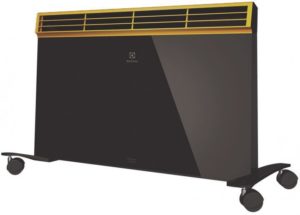
Heating element types
Heating elements used in convectors are:
- heating elements;
- monolithic elements.
Tens, in turn, are divided into:
- needle-shaped;
- tubular.
Needle heating elements consist of a dielectric plate with a nichrome thread attached to it, which serves as a heater. It is coated with insulating varnish. This element heats up quickly. The main disadvantage is the short service life. The thread burns out quickly.
Tubular elements consist of metal tubes containing a nichrome thread (sometimes nickel). They are separated from the tube body by a thermally conductive insulating powder. And the surface of the tubes is covered with aluminum fins, which transfer heat well. They have a longer service life than needle ones. There are models in which the heating element is protected from splashes; such convectors are suitable for use in bathrooms. But there is also a big drawback: the tube and fins are made of different materials. Each one has a different heating and cooling period. As a result, when it cools down, a cracking sound appears in the device.
For monolithic heaters, the body and the heating element are made as a single whole, i.e. are not separated. They have high efficiency and increased efficiency.
Temperature regulators
Three types of thermostats are used in convectors:
- mechanical;
- electronic;
- programmable.
A mechanical thermostat has a simple design and low cost, but has a number of disadvantages:
- creates a lot of noise due to clicks when modes are switched;
- does not always accurately maintain the temperature of the selected mode;
- wears out quickly due to constant turning;
- does not always cope with its function, it is dangerous to leave it unattended for a long time.
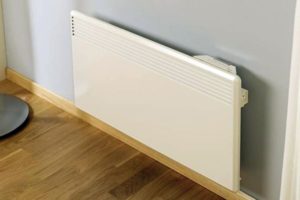
An electronic thermostat is better than a mechanical one in many respects and has the following advantages:
- works silently;
- minor error when maintaining temperature;
- saves electricity;
- there is the possibility of remote adjustment using the remote control;
- you can set several modes of operation;
- Built-in protected control unit to increase safety during use.
But there are also disadvantages; it costs much more than a mechanical one.
A programmable thermostat allows you to ensure autonomous operation of the convector using programs. Such models not only have remote control, they can be connected to them at a remote distance using mobile devices, via smartphones. You don’t have to be nearby for them to work; you can control them from the other end of the country.
Additional features
Many modern models have a number of additional functions. For example, some models are equipped with humidifiers. Since convectors have a disadvantage, they make the air dry, this function compensates for this disadvantage. In addition, like temperature control, this function is equipped with automatic control. If the sensors detect increased dryness of the air, the humidifier immediately turns on and turns off when the norm is reached.
Types of convectors
Types of convectors are classified depending on a number of parameters. There are several classifications:
- depending on installation (floor, wall, ceiling, etc.);
- by element used (gas, water, electricity);
- by type of circulation: natural, forced.
Floor convectors are one of the most convenient and easy to move from one place to another. A significant disadvantage is the cord with the socket. Let's say, if there is a small child in the house, then this can become a problem, he can constantly pull it out of the socket and play with it. Yes, and you can get hooked on it yourself.
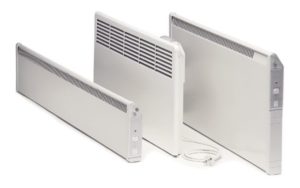 Built-in convectors are a good solution for a large room, since wall-mounted ones cannot cope with heating large areas.But their disadvantage is that they need to be designed during the construction of the building, since it is necessary to install a pipe through which the coolant will flow.
Built-in convectors are a good solution for a large room, since wall-mounted ones cannot cope with heating large areas.But their disadvantage is that they need to be designed during the construction of the building, since it is necessary to install a pipe through which the coolant will flow.
Today, water convectors are an alternative to radiators. The coolant passes through the pipes, which heats the plates and air of the convector.
Gas convectors are considered one of the cheapest. But they have the lowest security and installation complexity. Therefore, they are used very rarely.
Electric convectors are considered the simplest. They are both easy to install and easy to use. There is no need to lay pipes, buy a boiler and connect to it, or connect to the heating system, etc. And therefore, there is no need to coordinate with anyone or obtain the necessary decisions.
Important! There are also some disadvantages, primarily safety. This type of convector requires strict adherence to safety measures.
Convectors with forced air circulation are equipped with a fan that performs two functions: it helps air circulation and serves as a cooler if the device overheats.
Advantages of electric convectors
Modern electric convectors have a number of advantages. For example, for heating a country house, there is no better option. No plumbing, no gas pipes, no installation of boilers or battery systems are required. It is enough to have an outlet in the room. The main advantages are:
- simple installation and operation;
- long service life;
- affordable price;
- automation, both during operation and temperature support;
- high efficiency;
- rapid heating of the air.
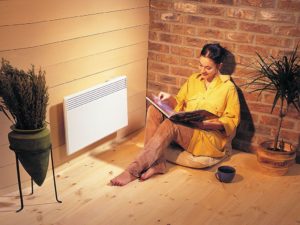
The disadvantages mainly include the high consumption of electricity when heating the room.On the other hand, there is no need to prepare firewood, briquettes, or other heat carriers. Plugged it in and got heat.
Thus, convectors, which came into our lives relatively recently, are taking up more and more space in our everyday life and, perhaps, will soon become an integral element in it, just as an ordinary light bulb once became.




